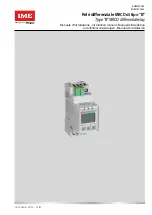
ABB Power T&D
Company Inc.
Relay Division
Coral Springs, FL 33065
Instruction Leaflet
I.L.
41-553.1G
Type BL-1 Thermal
Overload Relay
Effective February 1978
Supersedes I.L. 41-553.1 F dated January 1976
* Denotes change since previous issue
CAUTION:
Before putting relays into service,
remove all blocking which may have been inserted
for the purpose of securing the parts during ship-
ment, make sure that all moving parts operate
freely, inspect the contacts to see that they are
clean and close properly, and operate the relay to
check the settings and electrical connections.
APPLICATION
The type BL-I relay is used primarily for
thermal overload and instantaneous overcurrent
protection of motors and generators, but it may
also be used for the protection of transformers or
any other apparatus if the temperature-rise under
overload is similar to that of motors. The thermal
element is the “replica type” and has a time-
current characteristic closely approximating the
average moderate overload heating curves of
motors. Its characteristics prevent the protected
equipment from being subjected to overloads of
such magnitude or duration as to cause them to
reach dangerous temperatures, but at the same
time permit the utilization of the inherent thermal
capacity of the apparatus.
As its operation depends upon the rate of heat
generation in a heater element within the relay, it
may be used for either ac or dc application. It is
ordinarily connected in the secondary circuit of a
suitable current transformer in ac applications.
Since the voltage drop across the relay must be
within a range of about 0.49 to 0.88 volts at full
load on the protected machine, customary shunts
rated in millivolts are unsuited for dc applications.
However,
the drop across a portion of the
protected circuit, such as the interpole field win-
ding of a machine, sometimes can be utilized as a
source of energy for the relay.
CONSTRUCTION AND OPERATION
The single element type BL-1 relay consists of
a heater unit, an instantaneous overcurrent unit,
0 two operation indicators, and a contactor switch.
(Figures
1 &
3).
The double element type BL-1 relay contains
two heater units, two instantaneous units, three
0 operation indicators, and a contactor switch.
(Figures 2 & 4).
THERMAL UNIT
The thermal unit consists of a housing of mold-
ed material which encloses a coiled thermostatic
metal spring mounted on a shaft, two die-cut
heater elements made of resistance material, metal
heat storage blocks, and bearings for the shaft;
and, external to the molded housing, a second ther-
mostatic metal spring fastened to the shaft exten-
sion and carrying the moving contact at its outer
end, the stationary contacts, and scales for setting
the stationary contacts at suitable positions for ob-
taining various time-overload operating curves un-
der specified operating conditions.
The external and internal thermostatic metal
springs have identical temperature-angular rota-
tion characteristics, and the external spring is
mounted so that its rotation is in the opposite
direction to that of the internal spring. Conse-
quently, a change in ambient temperature will not
produce an appreciable permanent change in the
position of the moving contacts, although the
All possible contingencies which may arise during installation, operation, or maintenance, and all details
and variations of this equipment do not purport to be covered by these instructions. If further information
is desired by purchaser regarding this particular installation, operation or maintenance of this equipment,
the local Asea Brown Boveri representative should be contacted.


































